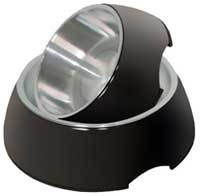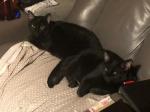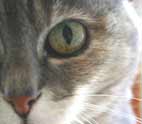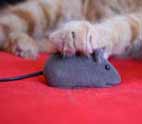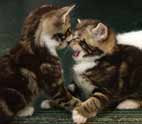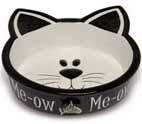Cat Acne - What Is It?
Cat acne, yes there really is such a thing, but I bet not many people have heard of it, this is unusual as feline acne is quite common.
However just like human acne it can be treated and is not considered to be a serious health problem. So if you suspect that your cat may be suffering from this condition, read on to find out just what can be done about it.
What Is Feline Acne
Acne as we all know is a condition where areas of skin become red and inflamed and sometimes weeps. It can be itchy and scaly too sometimes. Pimples and blackheads also form in the area.
We have all seen out cats rubbing their chins and heads over things all the time to leave their scent on them. This is because our cats have sebaceous glands on several parts of their bodies which produce an oil like substance which is used to keep the skin and hair healthy. They are also used to scent mark territory.
|
Mild case looks like black specks on chin. 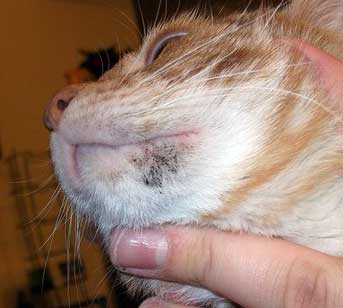 |
Severe case, bleeding caused by cat scratching at chin and bursting swollen pustules. 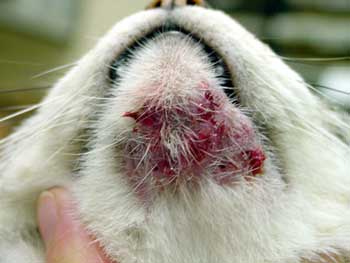 |
Cat acne mainly occurs in the chin area as this is one of the main glands used for rubbing against and can be a difficult area for the cat to clean effectively. However the cat does posses several other sebaceous glands which are situated in the base of the tail, scrotum, eyelids and the back. Another form of acne can occur on the back of the cat near the tail, this is often called "stud tail".
The condition can occur in cats of all ages and can be a lifetime condition which comes and goes in severity.
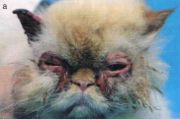
There is a severe form of feline acne which can affect Persian cats and is known as Idiopathic Persian facial dermatitis and is often referred to as "Dirty Face". A build up of a waxy like substance appears all over the face especially around the eyes. This can only be treated by a vet and can be quite difficult to control.
The Causes Of Cat Acne
There are several causes of feline acne:
- Over active sebaceous oil glands - If too much oil is
produced by the glands then it will cause the skin to become greasy which is
easy for dirt to build up in and cause blocked pores and hair follicles.
- Lack of grooming - Some cats find it difficult to clean
their chin area or they may even be lazy groomers. Either way if the chin is
not cleaned regularly to allow for the removal of access oil and dirt, then
blackheads can form and this leads onto cat acne.
- Stress - Just like us humans who notice that in times of
stress our skin breaks out in pimples, our cats can also suffer a similar fate.
Stress can affect hormone levels which in turn affect the glands, which can
become over active.
- Allergy - It has been suggested that some cats may suffer an allergic reaction to plastic feeding bowls. Plastic bowls are porous and can trap bacteria which can then be transferred to your cats chin.
How Do You Know If Your Cat Has Acne?
There are several obvious symptoms you can watch out for, they are:
- Black spots on chin and sometimes lips too
- Swollen chin
- Red pimples on the chin which may bleed if the cat scratches at them.
In severe cases the chin will look very inflamed and the cat will be scratching at it all the time to rid themselves of the itch. The chin may look wet all the time.
It is advisable to have your cat checked by a vet to make sure that the symptom your cat is displaying is not caused by something else. There are a few other conditions which may at first look like acne, such as:
- Bacterial Pyoderma
- Dermatitis
- Malassezia
Treating Feline Acne
Mild cases - In most cases cat acne is mild and can be easily treated at home. It is important to keep the area clean, so washing the chin with warm water and a mild antibiotic soap or Epsom salts should be daily.
|
Severe cases - However if the condition becomes more severe then often a vet will advise washing the area twice a week with Benzoyl peroxide shampoo ( please follow the directions for use carefully). They may also prescribe antibiotics and inflammation reducing drugs. Your vet may recommend a topical cream for the chin if the condition is severe enough but this can be tricky to use as cats are very good at washing off creams etc. A head collar may have to be worn for a period of time after application. |
|
Plastic Bowls - Replacing any plastic bowls your cat may use with ceramic, steel or glass ones is a must. Also make sure the bowls are cleaned daily. This can really help reduce the severity of the condition in cats who are prone to chin acne. Messy Eaters - if your cat often ends up with food on their chin after eating, it may be an idea to help them out by gently washing their chins with warm water after eating to give them a helping hand at face cleansing. |
